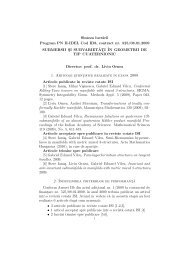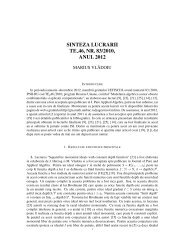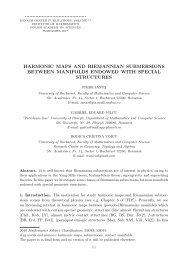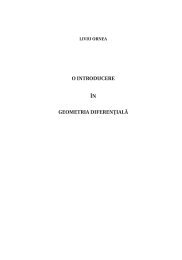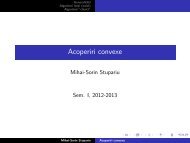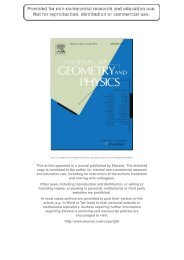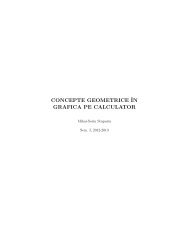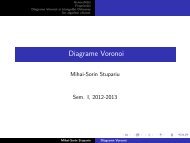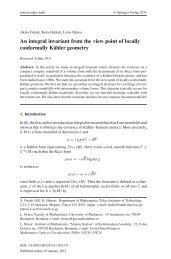arXiv:math.AG/0407231 v2 20 Jul 2004
arXiv:math.AG/0407231 v2 20 Jul 2004
arXiv:math.AG/0407231 v2 20 Jul 2004
Create successful ePaper yourself
Turn your PDF publications into a flip-book with our unique Google optimized e-Paper software.
<strong>arXiv</strong>:<strong>math</strong>.<strong>AG</strong>/<strong>0407231</strong> <strong>v2</strong> <strong>20</strong> <strong>Jul</strong> <strong>20</strong>04<br />
LCK manifolds with potential L. Ornea and M. Verbitsky, 14 <strong>Jul</strong>y <strong>20</strong>04<br />
Contents<br />
Locally conformal Kähler<br />
manifolds with potential<br />
Liviu Ornea and Misha Verbitsky 1<br />
Abstract<br />
A locally conformally Kähler (LCK) manifold M is one<br />
which is covered by a Kähler manifold M with the deck<br />
transform group acting conformally on M. If M admits<br />
a holomorphic flow, acting on M conformally, it is called<br />
a Vaisman manifold. Neither the class of LCK manifolds<br />
nor that of Vaisman manifolds is stable under small deformations.<br />
We define a new class of LCK-manifolds, called<br />
LCK manifolds with potential, which is closed under small<br />
deformations. All Vaisman manifolds are LCK with potential.<br />
We show that an LCK-manifold with potential<br />
admits a covering which can be compactified to a Stein<br />
variety by adding one point. This is used to show that<br />
any LCK manifold M with potential, dim M 3, can be<br />
embedded to a Hopf manifold, thus improving on similar<br />
results for Vaisman and Sasakian manifolds ([OV2]).<br />
1 Introduction 2<br />
1.1 Motivation . . . . . . . . . . . . . . . . . . . . . . . . . . . . 2<br />
1.2 Basic definitions . . . . . . . . . . . . . . . . . . . . . . . . . 2<br />
2 LCK manifolds with potential 3<br />
2.1 LCK manifolds and monodromy . . . . . . . . . . . . . . . . 3<br />
2.2 Deformations of LCK manifolds with potential . . . . . . . . 5<br />
3 Holomorphic contractions on Stein varieties 6<br />
3.1 Filling a Kähler covering of an LCK-manifold with potential . 6<br />
3.2 Holomorphic flow and Z-equivariant maps . . . . . . . . . . . 8<br />
1<br />
Misha Verbitsky is an EPSRC advanced fellow supported by CRDF grant RM1-2354-<br />
MO02 and EPSRC grant GR/R77773/01.<br />
Keywords: locally conformal Kähler manifold, Kähler potential, Lee field, Vaisman<br />
manifold, Hopf manifold, Stein variety, Poincare-Dulac theorem<br />
<strong>20</strong>00 Mathematics Subject Classification: 53C55, 32G05.<br />
1
LCK manifolds with potential L. Ornea and M. Verbitsky, 14 <strong>Jul</strong>y <strong>20</strong>04<br />
1 Introduction<br />
1.1 Motivation<br />
The study of algebraic geometry of compact non-Kähler manifolds is stymied<br />
by the lack of metric structures and unability to apply most differential<br />
geometric and analytic arguments. However, in many examples of non-<br />
Kähler manifold, the metric structures arise naturally. The most common<br />
example of these is given by the locally conformally Kähler (LCK) geometry.<br />
An LCK manifold is one admitting a Kähler covering M with the deck<br />
transform acting on M by conformal transforms. The first examples of non-<br />
Kähler manifolds were Hopf manifolds, that is, the quotients of C n \0 by a<br />
cyclic group 〈A〉 generated by an invertible linear operator A : C n −→ C n ,<br />
with all eigenvalues < 1. Such a quotient is obviously locally conformally<br />
Kähler (see e.g. [GO]). For a long time it was conjectured that all non-<br />
Kähler complex surfaces are LCK (this conjecture was disproven). Still, the<br />
ubiquity of LCK manifolds is hard to overestimate.<br />
LCK manifolds have been widely studied in the last 30 years. They<br />
share some properties with the Kähler manifolds (they are stable to blow-up,<br />
satisfy an embedding theorem of Kodaira type, cf. [OV2] and the last section<br />
here), but they also contrast Kähler geometry. A striking feature is that a<br />
deformation of an LCK manifold is not LCK. Even the smaller (and better<br />
understood) subclass of Vaisman manifolds is not stable at deformations<br />
(both results were proved in [B1] by finding appropriate counterexamples).<br />
On the other hand, it was proven in [V2] that the Kähler metric of the<br />
universal covering of a Vaisman manifold admits a Kähler potential. This<br />
property is stable to small deformations and hence a Vaisman manifold<br />
deforms to a LCK one (but not necessarily Vaisman).<br />
This suggests the need for a new subclass of LCK manifolds, called<br />
LCK manifolds with potential, stable under deformations and containing<br />
Vaisman manifolds. It is the aim of this paper to study the LCK manifolds<br />
with potential. We obtain a Kodaira-type embedding theorem for LCKmanifolds<br />
with potential (Theorem 3.4), embedding each into an appropriate<br />
Hopf manifold, not necessarily of Vaisman type.<br />
1.2 Basic definitions<br />
Let (M,I,g) be a connected complex Hermitian manifold of complex dimension<br />
at least 2. Denote by ω its fundamental Hermitian two-form, with the<br />
convention ω(X,Y ) = g(X,IY ).<br />
2
LCK manifolds with potential L. Ornea and M. Verbitsky, 14 <strong>Jul</strong>y <strong>20</strong>04<br />
Definition 1.1: (M,I,g) is called locally conformal Kähler (LCK) if<br />
there exists a closed one-form θ (called the Lee form) such that:<br />
dω = θ ∧ ω.<br />
Equivalently, any cover M of M on which the pull-back θ of θ is exact<br />
(in particular, the universal cover), carries a Kähler form Ω = e −f ω, where<br />
θ = df, and such that π1(M) acts on M by holomorphic homotheties. Conversely,<br />
a manifold admitting such a Kähler covering is necessarily locally<br />
conformally Kähler.<br />
For many equivalent definitions and examples, the reader is referred to<br />
[DO] and [OV2].<br />
The most important subclass of LCK manifolds is defined by the parallelism<br />
of the Lee form with respect to the Levi-Civita connection of g ([Va],<br />
[DO]).<br />
Definition 1.2: An LCK manifold (M,I,g) is called a Vaisman manifold<br />
if ∇θ = 0, where ∇ is the Levi-Civita connection of g.<br />
According to [KO], the compact Vaisman manifolds can be defined as<br />
an LCK manifolds admitting a conformal holomorphic flow which does not<br />
induce an isometry on M.<br />
Vaisman geometry is intimately related to Sasakian one (see [OV1]). On<br />
the other hand, the Kähler form Ω on the universal covering of a Vaisman<br />
manifold admits a Kähler potential (cf. [V2] and the next section).<br />
2 LCK manifolds with potential<br />
2.1 LCK manifolds and monodromy<br />
The main object of this paper is described in the following<br />
Definition 2.1: An LCK manifold with potential is a manifold which<br />
admits a Kähler covering ( M,Ω), and a positive smooth function ϕ : M →<br />
R >0 (the LCK potential) satisfying the following conditions:<br />
1. It is proper, i.e. its level sets are compact.<br />
3
LCK manifolds with potential L. Ornea and M. Verbitsky, 14 <strong>Jul</strong>y <strong>20</strong>04<br />
2. The monodromy map τ acts on it by multiplication with a constant<br />
τ(ϕ) = const · ϕ.<br />
3. It is a Kähler potential, i.e. − √ −1 ∂∂ϕ = Ω.<br />
Remark 2.2: Let Γ be the monodromy (deck transform) group of M → M,<br />
and χ : Γ −→ R >0 a homomorphism mapping γ ∈ Γ to the number γ(ϕ)<br />
ϕ .<br />
Consider the covering M ′ := M/ker χ. Clearly, ϕ defines a Kähler potential<br />
ϕ ′ on M ′ , and ϕ ′ satisfies assumptions (1)-(3) of Definition 2.1. Therefore,<br />
we may always choose the covering M in such a way that χ : Γ −→ R >0 is<br />
injective. Further on, we shall always assume that χ is injective whenever<br />
an LCK manifold with potential is considered.<br />
Remark 2.3: Any closed complex submanifold of an LCK-manifold with<br />
potential is also an LCK-manifold with potential.<br />
Note that, by [V2, Pr. 4.4], all compact Vaisman manifolds do have a<br />
potential. Indeed, on M, we have θ = dϕ, where ϕ = Ω(θ,I(θ)). Using the<br />
parallelism, one shows that Ω = e −ϕ ω is a Kähler form with potential ϕ.<br />
The two non-compact, non-Kähler, LCK manifolds constructed recently<br />
by J. Renaud in [Re] do also have a potential.<br />
In both cases the monodromy is isomorphic to Z, hence, by Proposition 2.7<br />
below, condition (1) in the definition is fulfilled.<br />
Claim 2.4: Let M be an LCK-manifold with potential, M the corresponding<br />
cover with the monodromy Γ, and χ : Γ −→ R >0 the injective character<br />
constructed above. Then the image of χ is discrete in R >0 , in other words,<br />
Γ is isomorphic to Z.<br />
Proof: Let γ be a non-trivial element. Then ϕ defines a continuous and<br />
proper map<br />
M/〈γ〉 ϕ1 >0<br />
−→ R /〈ϕ(γ)〉 ∼ 1<br />
= S .<br />
Since R >0 /〈ϕ(γ)〉 is compact, and ϕ1 is proper, M/〈γ〉 is also compact. On<br />
the other hand, Γ/〈γ〉 acts freely on M/〈γ〉. Therefore, Γ/〈γ〉 is finite.<br />
The following elementary claim is well known.<br />
4
LCK manifolds with potential L. Ornea and M. Verbitsky, 14 <strong>Jul</strong>y <strong>20</strong>04<br />
Claim 2.5: Let M be an LCK-manifold, θ its Lee form, ( M,Ω) its Kähler<br />
cover, Γ its monodromy, and χ : Γ −→ R >0 the corresponding character,<br />
Then <br />
γ θ = log χ(γ).<br />
χ(γ) = γ(Ω)<br />
Ω .<br />
Conjecture 2.6: In assumptions of Claim 2.5, the image of χ is discrete in<br />
R >0 . Equivalently, the set <br />
of periods of θ is discrete in R.<br />
[H1 θ<br />
(M,Z)]<br />
If Conjecture 2.6 is true, then the first assumption of Definition 2.1 can<br />
be dropped:<br />
Proposition 2.7: Let M be an LCK-manifold, M −→ M its Kähler covering,<br />
χ : Γ −→ R >0 the character defined above, and ϕ a Kähler potential<br />
on M which satisfies γ(ϕ) = χ(γ)ϕ. Assume that χ is injective. Then ϕ is<br />
proper if and only if the image of χ is discrete in R >0 .<br />
Proof: The “only if” part is proven in Claim 2.4. Assume, conversely, that<br />
the image of χ is discrete. Then Γ is isomorphic to Z, and ϕ defines a map<br />
M/〈γ〉 ϕ1<br />
−→ R >0 /〈ϕ(γ)〉,<br />
where γ is the generator of Γ. Since M/〈γ〉 = M, and M is compact, this<br />
map is proper. Its fibers are naturally identified with the level sets of ϕ, and<br />
therefore they are compact, and ϕ is proper.<br />
2.2 Deformations of LCK manifolds with potential<br />
With an argument similar to the one in [OV2, Th. 4.5], noting that small<br />
deformations of positive potentials remain positive, we derive<br />
Theorem 2.8: The class of compact LCK manifolds with potential is stable<br />
under small deformations.<br />
5
LCK manifolds with potential L. Ornea and M. Verbitsky, 14 <strong>Jul</strong>y <strong>20</strong>04<br />
Proof: Let (M,I ′ ) be a small deformation of (M,I). Then ϕ is a proper<br />
function on ( M,I ′ ) satisfying γ(ϕ) = χ(γ)ϕ. It is strictly plurisubharmonic<br />
because a small deformation of a strictly plurisubharmonic function is again<br />
strictly plurisubharmonic. Therefore, ( M,I ′ ) is Kähler, and ϕ is an LCKpotential<br />
on ( M,I ′ ).<br />
Hence, in particular, any compact Vaisman manifold deforms to a LCK<br />
one. This explains a posteriori why the construction in [GO] worked for<br />
deforming the Vaisman structure of a Hopf surface of Kähler rank 1 to a non-<br />
Vaisman LCK structure on Hopf surface of Kähler rank 0 which, moreover,<br />
by [B1], does not admit any Vaisman metric.<br />
On the other hand, not all LCK manifolds admit an LCK potential. For<br />
example, one may consider the blow up of a point on a compact Vaisman<br />
manifold. Moreover, the LCK structure of the Inoue surfaces do not admit<br />
potential, since they can be deformed to the non-LCK type Inoue surface<br />
S + n;p,q,r,u with u ∈ C \ R (cf. [B1]).<br />
3 Holomorphic contractions on Stein varieties<br />
3.1 Filling a Kähler covering of an LCK-manifold with potential<br />
Theorem 3.1: Let M be a LCK manifold with a potential, dimM 3,<br />
and M the corresponding covering. Then M is an open subset of a Stein<br />
variety Mc, with at most one singular point. Moreover, Mc\ M is just one<br />
point.<br />
Proof: Consider the subset<br />
M(a) = {x ∈ M | ϕ(x) > a}.<br />
By the properties of the potential function, this set is holomorphically concave.<br />
By Rossi-Andreotti-Siu theorem (cf. [Ro, Th. 3, p. 245] and [AS, Pr.<br />
3.2]) M(a) can be compactified: it is an open subset of a Stein variety Mc,<br />
with (at most) isolated singularities 1 . The ring of holomorphic functions<br />
on the ”filled in” (see also [MD]) part of M(a) is identified with the ring<br />
of CR-functions on the level set ϕ −1 (a). Therefore, one could extend the<br />
embedding M(a) → Mc to M → Mc, filling all M to a Stein variety with at<br />
most isolated singularities.<br />
1 It is here that the restriction on the dimension is essential.<br />
6
LCK manifolds with potential L. Ornea and M. Verbitsky, 14 <strong>Jul</strong>y <strong>20</strong>04<br />
We show that Mc is obtained from M by adding only one point.<br />
The deck transform (monodromy) group Γ ∼ = Z acts on Mc by non-trivial<br />
conformal automorphisms. Let γ be its generator, which is a contraction 2<br />
(that is, γ maps Ω to λ · Ω with λ < 1). Consider a holomorphic function<br />
f on Mc. The variety Mc is covered by a sequence of compact subsets<br />
Br = Mc\ M(r). Since γ maps Br to Bλr, the sequence γ n f in uniformly<br />
bounded on compact sets. Therefore, it has a subsequence converging to a<br />
holomorphic function, in the topology of uniform convergence on compact<br />
sets. It is easy to see that the limit reaches its maximum on any Br, hence<br />
by maximum principle this limit is constant. On the other hand, supγ n f<br />
stays the same, hence the limit is the same for all subsequences of γ n f. We<br />
obtain that γ n f converges to a constant.<br />
The set Z := Mc\ M is by construction compact and fixed by Γ. Therefore,<br />
sup Z |γ n f| = sup Z |f| and infZ |γ n f| = infZ |f| for any holomorphic<br />
function f. Since γ n f converges to a constant, we obtain that infZ |f| =<br />
sup Z |f|. This implies that all globally defined holomorphic functions take<br />
the same value in all points of Z. The variety Mc is Stein, and therefore for<br />
any pair x,y ∈ Mc, x = y there exists a global holomorphic function taking<br />
distinct values at x,y. Therefore, Z is just one point.<br />
We obtained that Mc is a one-point compactification of M. This proves<br />
Theorem 3.1.<br />
Proposition 3.2: In assumptions of Theorem 3.1, denote the point Mc\ M<br />
by z. Let m be the ideal of z, and γ the monodromy generator, which acts on<br />
Mc. Then γ acts with eigenvalues strictly smaller than 1 on the cotangent<br />
space m/m 2 .<br />
Proof: It will be enough to carry on the argument on the tangent space. In<br />
the smooth situation, if γ fixes a point x and maps an open neighborhood<br />
U of x into a compact neighborhood of x contained in U, then γ will act<br />
on TxU as desired, as Schwarz lemma implies. In general, we already know<br />
that lim γ n f = const for any holomorphic function f. Now let v be an<br />
eigenvector of dxγ ∈ EndTxU with eigenvalue λ, such that dxf(v) = 0.<br />
Then dx(γ n f)(v) = λ n dxf(v). As γ n f converges to a constant, λ n dxf(v)<br />
converges to 0, and hence | λ |< 1.<br />
2 It has to be a contraction or an expansion, we make the first choice.<br />
7
LCK manifolds with potential L. Ornea and M. Verbitsky, 14 <strong>Jul</strong>y <strong>20</strong>04<br />
3.2 Holomorphic flow and Z-equivariant maps<br />
By Proposition 3.2, the formal logarithm of γ converges, and γ is obtained<br />
by integrating a holomorphic flow.<br />
Using an argument similar to [V1] we show that γ acts with finite Jordan<br />
blocks on the formal completion Ôz of the local ring Oz of germs of analytic<br />
functions in z ∈ Mc. But more is true: the formal solution of the ODE is in<br />
fact analytic, and hence γ acts with finite Jordan blocks on Ôz.<br />
Theorem 3.3: Let ν be a holomorphic flow on a Stein variety S, acting with<br />
eigenvalues strictly smaller than 1 on the tangent space TsS for some s ∈ S.<br />
Then there exists a sequence Vn ⊂ OsS of finite-dimensional subspaces in<br />
the ring of germs of analytic functions on S such that the s-adic completion<br />
of ⊕Vn equals the completion ÔsS of OsS and all of the Vn are preserved<br />
by ν (which acts by linear transformations of Vn).<br />
Proof: Taking an appropriate embedding of S, we may assume that S is an<br />
analytic subvariety of an open ball B in C n . Since S is Stein, the natural<br />
restriction map TsB → TsB|S is surjective, therefore ν can be extended to a<br />
holomorphic flow on B. As a consequence, it is enough to prove the theorem<br />
assuming S smooth.<br />
We take S to be an open ball in C n and s = 0. By the Poincaré-Dulac<br />
theorem (cf. [Ar, §23, p. 181]), after a biholomorphic change of coordinates,<br />
ν can be given the following normal form:<br />
ν(xi) = λixi + P(xi+1,... ,xn)<br />
where P(xi+1,...,xn) are resonant polynomials 3 corresponding to the eigenvalues<br />
λi.<br />
Let Vλi be the spaces generated by the coordinate functions xi corresponding<br />
to the eigenvalue λi and resonant monomials. By construction, ν<br />
preserves each Vλi . Taking a set Vλi 1 ,...,Vλi k , we see that ν also preserves<br />
the space Vλi 1 ,...,λi k generated by q1,... ,qk, with qj ∈ Vj. But a completion<br />
of all these Vλi 1 ,...,λi k is, by construction, equal with ÔsS.<br />
3 We recall, loc. cit., that an n-tuple λ = (λ1, . . . , λn) is called resonant if there exists<br />
an integral relation λs = (λ, m) := miλi, with m = (m1, . . . , mn), all mi 0 and<br />
| m |:= mi 2. Correspondingly, if the eigenvalue λ of an operator A is resonant<br />
and x m = x m1<br />
1 · · · x mn<br />
n is a monomial, xi being the coordinates of a vector x in a fixed<br />
eigenbasis {ei}, we say that the vector-valued monomial x m es is resonant if λs = (m, λ),<br />
| m | 2.<br />
8
LCK manifolds with potential L. Ornea and M. Verbitsky, 14 <strong>Jul</strong>y <strong>20</strong>04<br />
Picking enough holomorphic functions in these finite-dimensional eigenspaces,<br />
we find an embedding Mc ֒→ C n , such that the monodromy Γ acts on<br />
C n equivariantly. Then M is embedded to (C n \0)/Γ, where Γ acts linearly<br />
with eigenvalues strictly smaller than 1.<br />
We shall call such a quotient a Hopf manifold; to avoid confusion with<br />
class 0 Hopf surfaces of Kodaira - ”linear Hopf manifold”. It can be viewed<br />
as a generalization in any dimension of the class 0 Hopf surface. Clearly,<br />
such a Hopf manifold is LCK ([GO]) but, in general, not Vaisman.<br />
Using Strenberg’s normal form of holomorphic contractions (cf. [S]),<br />
Belgun also showed that Hopf manifolds are LCK and classified the Vaisman<br />
ones (they are precisely those for which the normal form of the contraction<br />
is resonance free), relating them to Sasakian geometry (see [B2]).<br />
As a result, we obtain the following:<br />
Theorem 3.4: Any compact LCK manifold M with potential, dimM 3,<br />
can be embedded to a linear Hopf manifold.<br />
Remark 3.5: The converse is also true, of course.<br />
This gives a new version of the Kodaira-type theorem on immersion of<br />
Vaisman manifolds to Vaisman-type Hopf manifolds (cf. [OV2]). In fact, a<br />
much stronger result is obtained.<br />
Theorem 3.6: Let M be a Vaisman manifold. Then M can be embedded<br />
to a Vaisman-type Hopf manifold H = (C n \0)/〈A〉, where A is a diagonal<br />
linear operator on C n with all eigenvalues < 1.<br />
Proof: Let Sa := ϕ −1 (a) be the level set of ϕ, and V the space of CRholomorphic<br />
functions on S. Using the solution of ∂-Neumann problem<br />
([MD]), we identify the L 2 -completion of V with the space of L 2 -integrable<br />
holomorphic functions on the pseudoconvex domain bounded by Sa.<br />
Let X := θ ♯ be the holomorphic vector field dual to the Lee form. According<br />
to the general results from Vaisman geometry ([DO, p. 37]), X is<br />
holomorphic. Therefore, X acts on V in a natural way. Denote by g the<br />
natural metric on Sa. Since X acts on M by homotheties ([DO, p. 37]), we<br />
have X(g) = cg. Therefore, X acts on V as a self-dual operator. Then, X<br />
is diagonal on any finite-dimensional subspace in V preserved by X. This is<br />
true for the spaces Vλi 1 ,...,λi k used to construct the embedding Mc −→ C n .<br />
9
LCK manifolds with potential L. Ornea and M. Verbitsky, 14 <strong>Jul</strong>y <strong>20</strong>04<br />
Consequently, we also improve the immersion result for Sasakian manifolds<br />
in [OV2, §6]:<br />
Theorem 3.7: Any compact Sasakian manifold admits a CR-embedding<br />
into a Sasakian weighted sphere, preserving the respective Reeb fields.<br />
After this work was completed, professor Hajime Tsuji communicated to<br />
us the reference to [Ka2]. In this work, Masahide Kato obtains a sufficient<br />
condition for a compact complex manifold Z of dimension 4 to dominate<br />
bimeromorphically a subvariety of a Hopf manifold, in terms of a certain<br />
effective divisor on D and a flat line bundle on Z.<br />
Also, in [Ka1], the following theorem was obtained. Let X be a complex<br />
space with a fixed point z, equipped with a holomorphic contraction, that<br />
is, an invertible morphism ψ : X −→ X such that for any sufficient small<br />
neighbourhood U of z, ψ k (U) lies inside U for k sufficiently big, and for all<br />
x ∈ X,<br />
lim<br />
k −→ ∞ ψk (x) = z.<br />
Then (X\z)/〈ψ〉 can be embedded into a Hopf manifold.<br />
Acknowledgements: Misha Verbitsky is grateful to D. Kaledin, D.<br />
Kazhdan, D. Novikov and P. Pushkar for interesting discussions, and D.<br />
Novikov for a lecture on normal forms and Poincaré-Dulac theorem. Also, a<br />
gratitude to IMAR in Bucharest for its hospitality during one week in May<br />
<strong>20</strong>04, when this research was initiated.<br />
References<br />
[AS] A. Andreotti and Y.T. Siu, Projective embeddings of pseudoconcave spaces, Ann. Sc. Norm.<br />
Sup. Pisa 24 (1970), 231–278.<br />
[Ar] V.I. Arnold, Geometrical methods in the theory of ordinary differential equations,<br />
Grundlehren der Mathematischen Wissenschaften 250, Springer Verlag, 1983.<br />
[B1] F.A. Belgun, On the metric structure of non-Kähler complex surfaces, Math. Ann. 317<br />
(<strong>20</strong>00), 1–40.<br />
[B2] F.A. Belgun, Hopf manifolds and Sasakian structures, Lecture given at CIRM <strong>20</strong>02,<br />
“Géométrie des variétés de petites dimensions et géométries spéciales”, video available at<br />
www.cirm.univ-mrs.fr/videos/index.php<br />
[DO] S. Dragomir and L. Ornea, Locally conformal Kähler geometry, Progress in Math. 155,<br />
Birkhäuser, Boston, Basel, 1998.<br />
10
LCK manifolds with potential L. Ornea and M. Verbitsky, 14 <strong>Jul</strong>y <strong>20</strong>04<br />
[GO] P. Gauduchon and L. Ornea, Locally conformally Kähler metrics on Hopf surfaces, Ann.<br />
Inst. Fourier 48 (1998), 1107–1127.<br />
[KO] Y. Kamishima, L. Ornea, Geometric flow on compact locally conformally Kähler manifolds,<br />
Tohoku Math. J. (to appear). Available at <strong>math</strong>.DG/0105040, 21 pages.<br />
[Ka1] Kato, Ma. Some remarks on subvarieties of Hopf manifolds, A Symposium on Complex<br />
Manifolds (Kyoto, 1974). Sûrikaisekikenkyûsho Kókyûroku No. 240 (1975), 64–87.<br />
[Ka2] Kato, Ma. On a characterization of submanifolds of Hopf manifolds, Complex analysis and<br />
algebraic geometry, pp. 191–<strong>20</strong>6. Iwanami Shoten, Tokyo, 1977.<br />
[MD] G. Marinescu and T.-C. Dinh, On the compactification of hyperconcave ends and the theorems<br />
of Siu-Yau and Nadel <strong>math</strong>.CV/0210485, <strong>v2</strong>.<br />
[OV1] L. Ornea and M. Verbitsky, Structure theorem for compact Vaisman manifolds, Math. Res.<br />
Lett. 10 (<strong>20</strong>03), 799–805.<br />
[OV2] L. Ornea and M. Verbitsky, Immersion theorem for compact Vaisman manifolds, Math.<br />
Ann. (to appear). Available at <strong>math</strong>.<strong>AG</strong>/0306077<br />
[Re] J. Renaud, Classes de variétés localemant conformément Kähleriennes non Kähleriennes,<br />
C.R. Acad. Sci. Paris 338 (<strong>20</strong>04), 925–928.<br />
[Ro] H. Rossi, Attaching analytic spaces to a analytic space along a pseudo-convex boundary,<br />
Proc. Conf. Complex Manifolds (Minneapolis), Springer Verlag, 1965, 242–256.<br />
[S] S. Sternberg, Local contractions and a theorem of Poincaré, Amer. J. Math. 79 (1957),<br />
809–824.<br />
[Va] I. Vaisman, Generalized Hopf manifolds, Geom. Dedicata 13 (1982), no. 3, 231–255.<br />
[V1] M. Verbitsky, Desingularization of singular hyperkähler varieties, II, alg-geom/961<strong>20</strong>13.<br />
[V2] M. Verbitsky, Vanishing theorems for locally conformal hyperkähler manifolds,<br />
<strong>math</strong>.DG/0302219.<br />
Liviu Ornea<br />
University of Bucharest, Faculty of Mathematics,<br />
14 Academiei str., 70109 Bucharest, Romania.<br />
Liviu.Ornea@imar.ro<br />
Misha Verbitsky<br />
University of Glasgow, Department of Mathematics,<br />
15 University Gardens, Glasgow, Scotland.<br />
Institute of Theoretical and Experimental Physics<br />
B. Cheremushkinskaya, 25, Moscow, 117259, Russia<br />
verbit@<strong>math</strong>s.gla.ac.uk, verbit@mccme.ru<br />
11



